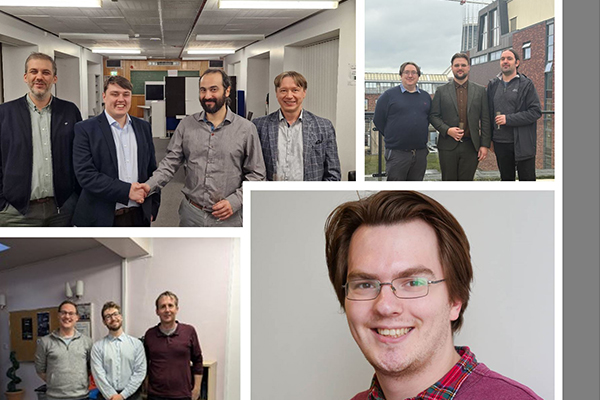Four more LIV.DAT students finish their PhDs

The last few months have seen several LIV.DAT students finish their PhDs. Students from both the University of Liverpool and Liverpool John Moores University have completed their studies and have gone to start their careers using skills they have acquired during their time with the CDT.
Jaiden Parlone of the University of Liverpool has completed his thesis called ‘Integrating Updated Interaction Models and a New Multi-Ring Event Sample for a Precision 3-Flavour Neutrino Oscillation Analysis at T2K’. For his thesis work Jaiden joined the T2K fitting group where he adroitly handled the task of adding further complexity to the already complex multi-dimensional neutrino oscillation fit. Now he has finished his PhD Jaiden is hoping to work in the nuclear power industry.
Andrew Mason has also completed his PhD at the Astrophysics Research Institute of Liverpool John Moores University. His thesis was titled ‘The accretion history of the Milky Way Halo from Massive Spectroscopic Surveys and Cosmological Simulations’. Since finishing his studies Andrew has started a Postdoc Position at the University of Liverpool with the same group he did his industrial placement with through Dirac Innovation where he looked at unifying multimodal healthcare data across NHS trusts and patient lifetimes in the Department of Pharmacology and Therapeutics.
Adam Lowe, who studied in the particle physics cluster at the University of Liverpool, has defended his thesis ‘Development of Liquid Argon TPC read-out technology for neutrino physics within the ARIADNE project’. His research focused on scaling up this novel neutrino detection technology for future large scale experiments such as DUNE. He is now working with the ARIADNE/Darkside group at the University of Liverpool as a postdoc.
Adam Tarrant, who also studied at the University of Liverpool has completed his thesis on Detector Simulations and Calibration for MeV Neutrino Searches in Water and Water based Liquid Scintillator (WbLS) Experiments. WbLS is a new detector medium which could lower the energy threshold of neutrino experiments while maintaining position, direction resolution and particle identification of traditional Cherenkov detectors. Working on Super-Kamiokande, Adam has developed a method of monitoring the relative change in Attenuation using the top diffuser. He also worked on the BUTTON experiment at Boulby where he built the simulations for the detector which will start to take data next year. As part of this work he spent a long period in California studying WbLS making some of the first measurement of it properties such as the attenuation length. Adam is now working as a Postdoc in the Department of Physics at the University of Liverpool continuing his work on BUTTON.
Congratulations to all of our recent graduates and we wish them all the best in their future careers!
Feature image:
Top left: Adam Lowe (second from left) and his supervisors.
Top right: Adam Tarrant (centre) and his supervisors.
Bottom left: Jaiden Parlone (centre) and his supervisors.
Bottom right: Andrew Mason